A Hybrid Methodology Based on Smart Management Energy Consumption in Irrigation Systems
Abstract
:1. Introduction
- An original method for optimal irrigation management to reduce energy consumption at for every 1000 cubic meters pumped;
- The adaptation of an integrated system for power consumption optimization in pumping groups to exploit the knowledge on the irrigation system operational characteristics;
- The validation of a proposed methodology presented in a case study that uses real input data from Romanian irrigation systems.
Irrigation Systems Status in the EU
2. Materials and Methods
2.1. The Expert Systems
efficiency point is recorded in the frequency band)
2.2. The Proposed Methodology for Irrigation Systems Control
- Introduction of the characteristic parameters for each pump: voltages, currents, frequencies (speeds) and flows for each hydraulic operating mode. First, all Measurements and the organization of the database is necessary. In this step, the data that must be mined is detected, then the appropriate input attributes and output information to represent the task are selected. The characteristic parameters for each pump are identified and organized in the database: voltages, currents, frequencies (speeds) and flows for each hydraulic operating mode. After the first step follows the hydraulic operating regime identification. The analysis was performed on a set of data with several stationary regimes, but without the technological possibility of balancing all possible hydraulic regimes of the pumping station.
- The input data acquisition and processing, and the calculation of the power consumed for each pump, i, where i indicates the pump number from the pumping groups (i = 1 … NP, where NP represents the total number of pumps from the pumping group) and n represents the number of measurements for a hydraulic operating mode. Thus, the input data subjected to the optimization process have these features recorded in a matrix [ID], having the size NP×n.where: NP represents the total number of pumps integrated in the pumping group from the irrigation system; Ui,n corresponds to the voltages measured for each pump, i, i = 1 … NP, in function of the number of measurements for a hydraulic operating mode, n; Iin indicates the currents measured for each pump, i, i = 1 … NP, in function of the number of measurements for a hydraulic operating mode, n; Fi,n represents the frequencies (speeds) measured for each pump, i, i = 1 … NP, in function of the number of measurements for a hydraulic operating mode, n; Pi,n indicates the instantaneous power calculated for each pump, i, i = 1 … NP, in function of the number of measurements for a hydraulic operating mode, n; Di,n corresponds to the flows measured for each pump, i, i = 1 … NP, in function of the number of measurements for a hydraulic operating mode, n; Pt,n represents the power on the equivalent pump in function of n; Dt,n indicates the flow on the equivalent pump in function of n; EPe,n represents the efficiency of the equivalent pump calculate in function of the number of measurements for a hydraulic operating mode, n; C_pi,n corresponds to the pumping cost calculated per 1000 cubic meters pumped per meters in the H2O column in function of the number of measurements for a hydraulic operating mode, n.
- Internal step. Frequency band for a hydraulic operating regime. In this step the flow and the power for the equivalent pump, as well as the efficiency of the equivalent pump and the pumping cost, are determined, including all of the parameters in the input data matrix. The following are the detailed parameters calculated in the internal step:
- Count the number of pumps switched on, to calculate the flow on the equivalent pump, Dt,n;
- Calculate the power of the equivalent pump, Pt,n;
- Determine the efficiency of the equivalent pump, EPe,n, using the following relation:where: Dt,n indicates the total flow in function of the number of measurements for a hydraulic operating mode, n, [m3/h]; Hs,n represents the pressure of the irrigation system in function of the number of measurements for a hydraulic operating mode, n, [bar]; Pt corresponds to the total power of the irrigation system, [kW]; Me indicates the engine efficiency, given by the catalog, 96%; Df represents the motor drive factor (transmission factor) data given by the catalog, [0.9–1].
- Calculate the pumping cost, C_pi,,n, [kW/1000 m3/mcH2O] per 1000 cubic meters pumped per meters in the H2O column, in function of the number of measurements for a hydraulic operating mode, n, with the relation:
- Graphical representation of the frequency-flow and frequency-power characteristics for each pump, F = f(Di), F = f(Pi). The maximum efficiency point is determined from the frequency-flow and frequency-power characteristics analysis. A characteristics representation is made for each pump of a particular hydraulic operating regime.
- Graphical representation of the frequency-efficiency and frequency- pumping cost for the equivalent pump, F = f(EPe,n), F = f(C_pi,n). For a higher accuracy in determining the maximum efficiency point of a pumping group, the frequency-efficiency and frequency-pump cost characteristics for the equivalent pump, of a hydraulic operating regime were determined.
- Determination of the maximum efficiency point of the hydraulic operating regime. In this last step a decision matrix, which takes into account the pumping cost, the pumping group efficiency and the total flow required at a constant pressure, is developed. From the decision matrix will result the optimal frequency band for which the pumping cost is minimal. The maximum efficiency point is determined for each hydraulic operating regime identified in the second step of the flow chart proposed.
3. Results
3.1. Case 1. Hydraulic Operating Mode with 2 Pumps in Operation
3.2. Case 2. Hydraulic Operating Mode with 3 Pumps in Operation
3.3. Case 3. Hydraulic Operating Mode with 4 Pumps in Operation
3.4. The Maximum Efficiency Point Determination Using the Decision Matrix
4. Discussion
5. Conclusions
Author Contributions
Funding
Conflicts of Interest
References
- Improving Pivot Irrigation Systems with Automation Direct. Available online: https://library.automationdirect.com/improving-pivot-irrigation-systems-with-automationdirect-issue-37-2017/ (accessed on 28 September 2021).
- Nikolaou, G.; Neocleous, D.; Katsoulas, N.; Kittas, C. Irrgation of Greenhouse Crops. J. Hortic. 2019, 5, 7. [Google Scholar] [CrossRef] [Green Version]
- Sowah, R.A.; Armoo, S.K.; Koumadi, K.M.; Agyeman, R.; Fiawoo, S.Y. Design and Development of an Efficient and Cost-Effective Microcontroller-Based Irrigation Control System to Enhance Food Security. Int. J. Electr. Inf. Eng. 2014, 8, 1343–1350. [Google Scholar]
- Agri-Environmental Indicator—Irrigation. Available online: http://ec.europa.eu/eurostat/statistics-explained/index.php/Agri-environmental_indicator_-_irrigation (accessed on 12 September 2021).
- Farm Level Optimal Water Management Assistant for Irrigation under Deficit. Available online: https://www.wur.nl/upload_mm/3/9/0/ba6fb1fe-5281-4f64-b4f9-1ce9dbd1c61f_FlowAid_Brochure.pdf (accessed on 3 September 2021).
- Environment Action Programme to 2030. Available online: https://ec.europa.eu/environment/strategy/environment-action-programme-2030_en#:~:text=These%20include%20biodiversity%20loss%2C%20climate%20change%2C%20resource%20use,climate%20action%20objectives%20of%20the%20European%20Green%20Deal (accessed on 15 September 2021).
- Automatic Watering System. Available online: http://www.novedades-agricolas.com/en/irrigation/irrigation-systems/authomatic-watering-system (accessed on 1 September 2021).
- Levidow, L.; Zaccaria, D.; Maia, R.; Vivas, E.; Todorovic, M.; Scardigno, A. Improving water-efficient irrigation: Prospects and difficulties of innovative practices. Agric. Water Manag. 2014, 146, 84–94. [Google Scholar] [CrossRef] [Green Version]
- Benzaouia, M.; Hajji, B.; Anne, M.-D.; Mellit, A.; Abdelhamid, R. An intelligent irrigation system based on fuzzy logic control: A case study for Moroccan oriental climate region. In Proceedings of the 2nd International Conference on Embedded Systems and Artificial Intelligence (ESAI’21), Fez, Morocco, 1–2 April 2021. [Google Scholar]
- Jamroen, C.; Komkum, P.; Fongkerd, C.; Krongpha, W. An Intelligent Irrigation Scheduling System Using Low-Cost Wireless Sensor Network toward Sustainable and Precision Agriculture. IEEE Access 2020, 8, 172756–172769. [Google Scholar] [CrossRef]
- Puy, A.; Borgonovo, E.; Lo Piano, S. Irrigated areas drive irrigation water withdrawals. Nat. Commun. 2021, 12, 4525. [Google Scholar] [CrossRef]
- Bagloee, S.A.; Asadi, M.; Patriksson, M. Minimization of water pumps’ electricity usage: A hybrid approach of regression models with optimization. Expert Syst. Appl. 2018, 107, 222–242. [Google Scholar] [CrossRef]
- Difallah, W.; Benahmed, K.; Draoui, B.; Bounaama, F. Linear Optimization Model for Efficient Use of Irrigation Water. Int. J. Agron. 2017, 2017, 5353648. [Google Scholar] [CrossRef] [Green Version]
- Singh, A.; Panda, S.N. Optimization and Simulation Modelling for Managing the Problems of Water Resources. Water Resour. Manag. 2013, 27, 3421–3431. [Google Scholar] [CrossRef]
- Azimi, V.; Salmasi, F.; Entekhabi, N.; Tabari, H.; Niaghi, A.R. Optimization of Deficit Irrigation Using Non-Linear Programming, (Case study:Mianeh region, Iran). Int. J. Agric. Crop. Sci. 2013, 6, 252–260. [Google Scholar]
- Bockari-Gevao, S.M.; Wan Ishak, W.I.; Azmi, Y.; Chan, C.W. Analysis of energy consumption in lowland rice-based cropping system of Malaysia. Songklanakarin J. Sci. Technol. 2005, 27, 819–826. [Google Scholar]
- Jiang, L.; Songa, J.; Li, M.; Shang, S.; Ma, X.; Yang, J.; Adeloyed, A. Optimization of irrigation scheduling for spring wheat based on simulation-optimization model under uncertainty. Agric. Water Manag. 2018, 208, 245–260. [Google Scholar]
- Galindo, J.; Torok, S.; Salguero, F.; De Campos, S.; Romera, J.; Puig, V. Optimal Management of Water and Energy in Irrigation Systems: Application to the Bardenas Canal. IFAC-PapersOnLine 2017, 50, 6613–6618. [Google Scholar] [CrossRef]
- Fang, Z.X.; Voron, B.; Bocquillon, C. Dynamic Programming: A Model for an Irrigation Reservoir. Hydrol. Sci. J. 1989, 34, 415–424. [Google Scholar] [CrossRef]
- Zhang, D.; Guo, P.; Liu, X.; Chen, J.; Jiang, C. Greenhouse Irrigation Optimization Decision Support System. In Proceedings of the 7th International Conference on Computer and Computing Technologies in Agriculture (CCTA), Beijing, China, 18–20 September 2013; Springer: Berlin/Heidelberg, Germany, 2014; pp. 10–23. [Google Scholar]
- Kuo, S.F.; Liu, C.W. Simulation and Optimization Model for Irrigation Planning and Management. Hydrol. Process. 2003, 17, 3141–3159. [Google Scholar] [CrossRef]
- De Ocampo, A.L.P.; Dadios, E.P. Energy Cost Optimization in Irrigation System of Smart Farm by Using Genetic Algorithm. In Proceedings of the IEEE 9th International Conference on Humanoid, Nanotechnology, Information Technology, Communication and Control, Environment and Management, Manila, Philippines, 1–3 December 2017. [Google Scholar] [CrossRef]
- Moradi-Jalal, M.; Rodin, S.I.; Marino, M.A. Use of Genetic Algorithm in Optimization of Irrigation Pumping Stations. J. Irrig. Drain. Eng. 2004, 130, 357–365. [Google Scholar] [CrossRef]
- Gao, L.; Zhang, M.; Chen, G. An intelligent irrigation system based on wireless sensor network and fuzzy control. J. Netw. 2013, 8, 1080–1087. [Google Scholar] [CrossRef]
- Mohapatraa, A.G.; Lenka, S.K. Neural Network Pattern Classification and Weather Dependent Fuzzy Logic Model for Irrigation Control in WSN Based Precision Agriculture. Procedia Comput. Sci. 2016, 78, 499–506. [Google Scholar] [CrossRef] [Green Version]
- Marinescu, T.; Arghira, N.; Hossu, D.; Fagarasan, I.; Stamatescu, I.; Stamatescu, G.; Calofir, V.; Iliescu, S. Advanced control strategies for irrigation systems. In Proceedings of the 9th IEEE International Conference on Intelligent Data Acquisition and Advanced Computing Systems: Technology and Applications, Bucharest, Romania, 21–23 September 2017. [Google Scholar] [CrossRef]
- Capraro, F.; Patino, D.; Tosetti, S.; Schugurensky, C. Neural Network-Based Irrigation Control for Precision Agriculture. In Proceedings of the IEEE International Conference on Networking, Sensing and Control, Sanya, China, 6–8 April 2008. [Google Scholar] [CrossRef]
- Srinivasan, R.; Engel, B.A.; Paudyal, G.N. Expert System for Irrigation Management. Agric. Syst. 1991, 36, 297–314. [Google Scholar] [CrossRef]
- Mohan, S.; Arumugam, N. Expert System Applications in Irrigation Management: An Overview. Comput. Electron. Agric. 1997, 17, 263–280. [Google Scholar] [CrossRef]
- Adeyemi, O.; Grove, I.; Peets, S.; Norton, T. Advanced Monitoring and Management Systems for Improving Sustainability in Precision Irrigation. Sustainability 2017, 9, 353. [Google Scholar] [CrossRef] [Green Version]
- Giannakis, E.; Bruggeman, A.; Djuma, H.; Kozyra, J.; Hammer, J. Water pricing and irrigation across Europe: Opportunities and constraints for adopting irrigation scheduling decision support systems. Water Sci. Technol. Water Supply 2016, 16, 245–252. [Google Scholar] [CrossRef] [Green Version]
- Wastewater. The Untapped Resource, The United Nations World Water Development Report. 2017. Available online: http://unesdoc.unesco.org/images/0024/002475/247553e.pdf (accessed on 28 August 2021).
- Intrigliolo, D. Water and Energy Advanced Management for Irrigation. The Future of Smart Irrigation Management in Europe, WEAM4i Policy Brief. 2014. Available online: www.weam4i.eu (accessed on 10 September 2021).
- Năstase, G.; Şerban, A.; Năstase, A.F.; Dragomir, G.; Brezeanu, A.I.; Iordan, N.F. Hydropower development in Romania. A review from its beginnings to the present. Renew. Sustain. Energy Rev. 2017, 80, 297–312. [Google Scholar] [CrossRef]
- National Program for Rehabilitation of the Main Irrigation Infrastructure in Romania. 2016. Available online: http://www.madr.ro/docs/agricultura/programul-national-reabilitare-irigatii-update.pdf (accessed on 9 September 2021).
- Agriculture in Romania 2017, Flanders Investment & Trade Market Survey. Available online: https://www.flandersinvestmentandtrade.com/export/sites/trade/files/market_studies/2017_Agriculture_Romania.pdf (accessed on 5 September 2021).
- Grigoras, G.; Scarlatache, F.; Comanescu, D.; Bogdan, C. Expert System for Optimal Power Allocation in Hydropower Dispatchable Units. In Proceedings of the International Conference OPTIM—ACEMP 2017 on Optimization of Electrical & Electronic Equipment—Aegean Conference on Electrical Machines and Power Electronics, Brasov, Romania, 25–27 May 2017; pp. 605–610. [Google Scholar]
- Mayadevi, N.; Vinodchandra, S.S.; Ushakumari, S. A Review on Expert System Applications in Power Plants. Int. J. Electr. Comput. Eng. (IJECE) 2014, 4, 116–126. [Google Scholar]
- Faisal, M.; Mohamed, A.; Shareef, H.; Hussain, A. Power Quality Diagnosis Using Time Frequency Analysis and Rule Based Techniques. Expert Syst. Appl. 2011, 38, 12592–12598. [Google Scholar] [CrossRef]
- Niebur, D. Expert Systems for Power System Control in Western Europe. In Proceedings of the 5th IEEE Int. Symposium on Intelligent Control, Philadelphia, PA, USA, 5–7 September 1990; pp. 34–40. [Google Scholar] [CrossRef]
- Gajbhiye, R.K.; Naik, D.; Dambhare, S.; Soman, S.A. An Expert System Approach for Multi-Year Short-Term Transmission System Expansion Planning: An Indian Experience. IEEE Trans. Power Syst. 2008, 23, 226–237. [Google Scholar] [CrossRef]
- HeungJae Lee, L.; ChaNyeon, K.; WonKun, Y. Application of an Expert System for Planning of Primary Restorative System. Int. J. Appl. Innov. Eng. Manag. (IJAIEM) 2016, 5, 301–305. [Google Scholar]
- León, C.; Biscarri, F.; Monedero, I.; Guerrero, J.I.; Biscarri, J.; Millán, R. Integrated expert system applied to the analysis of non-technical losses in power utilities. Expert Syst. Appl. 2011, 38, 10274–10285. [Google Scholar] [CrossRef]
- Liberado, E.V.; Marafão, F.P.; Simões, M.G.; De Souza, W.A.; Pomilio, J.A. Novel expert system for defining power quality compensators. Expert Syst. Appl. 2015, 42, 3562–3570. [Google Scholar] [CrossRef]
- Gua, J.S.; De Silva, C.W. Development and Implementation of a Real-Time Open-Architecture Control System for Industrial Robot Systems. Eng. Appl. Artif. Intell. 2004, 17, 469–483. [Google Scholar] [CrossRef]
- Devedžić, V. REX: Robotics expert systems building tool. Eng. Appl. Artif. Intell. 1989, 2, 286–299. [Google Scholar] [CrossRef]
- Cârţină, G.; Grigoraş, G. Artificial Intelligence Techniques in Electroenergetics; House Publishing SETIS: Iasi, Romania, 2004. [Google Scholar]
- Garbea, R.; Scarlatache, F.; Grigoras, G.; Neagu, B. Integration of Data Mining Techniques in SCADA System for Optimal Operation of Hydropower Plants. In Proceedings of the 2021 13th International Conference on Electronics, Computers and Artificial Intelligence (ECAI), Pitesti, Romania, 1–3 July 2021; pp. 1–6. [Google Scholar] [CrossRef]

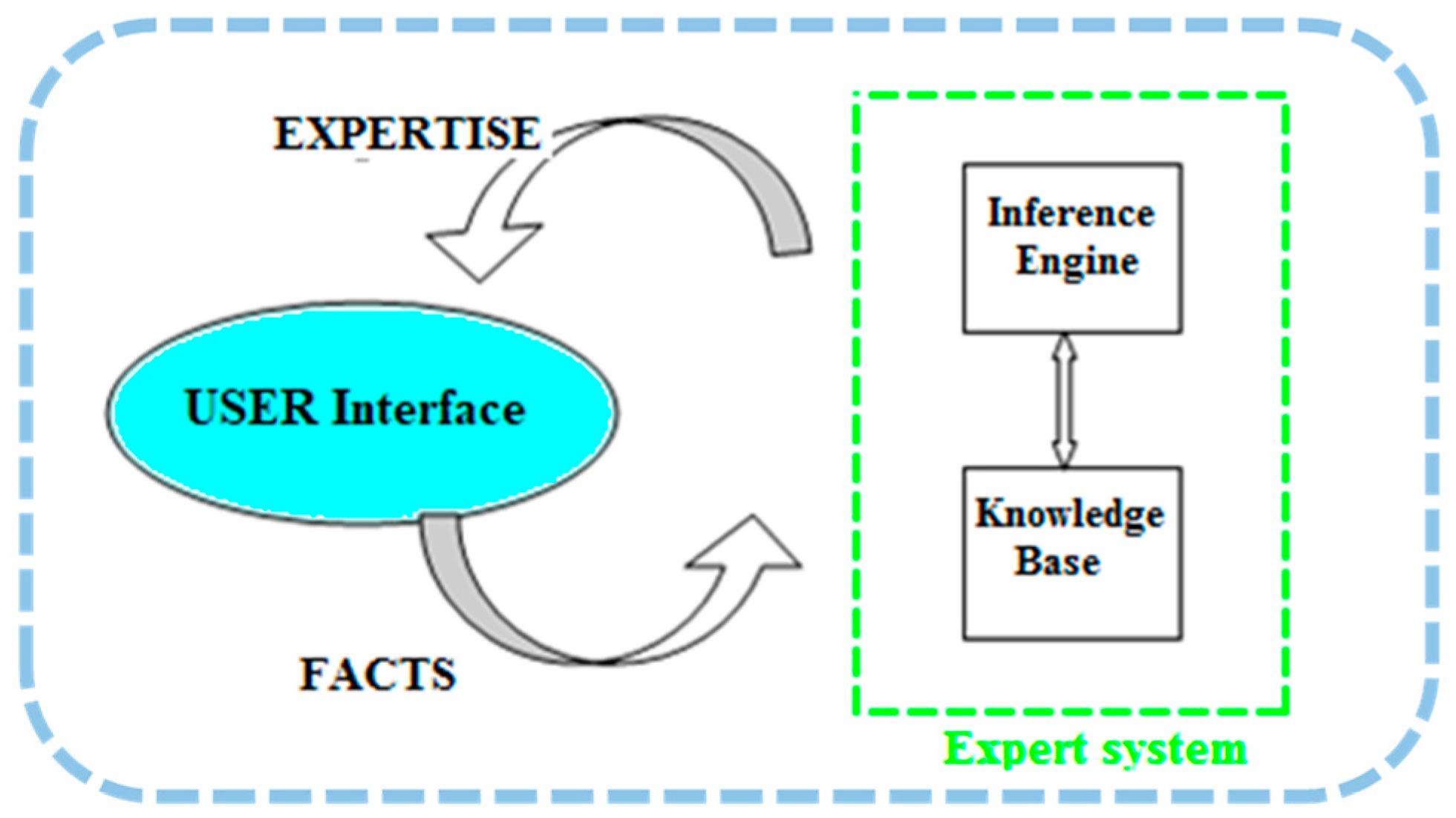
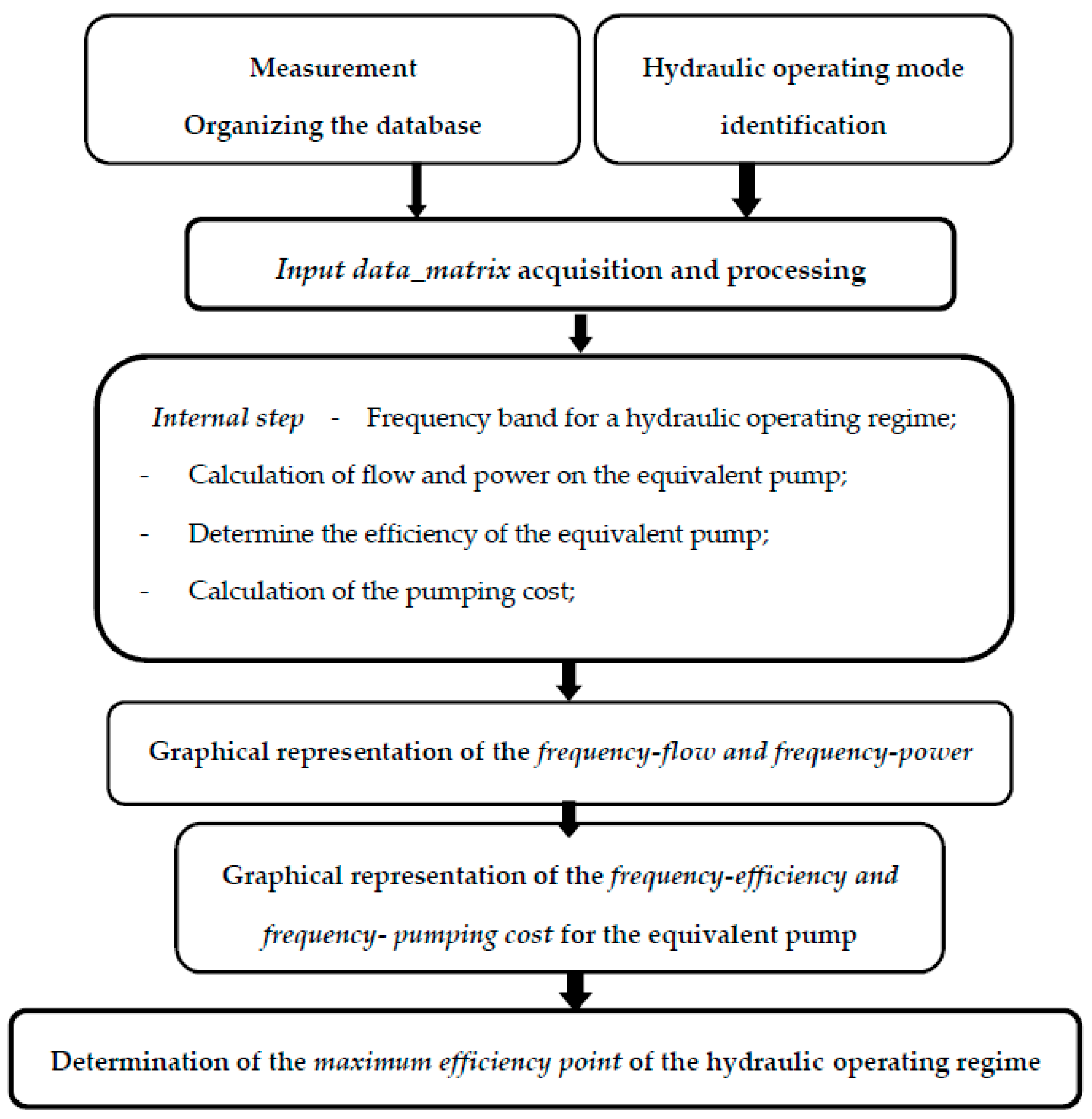
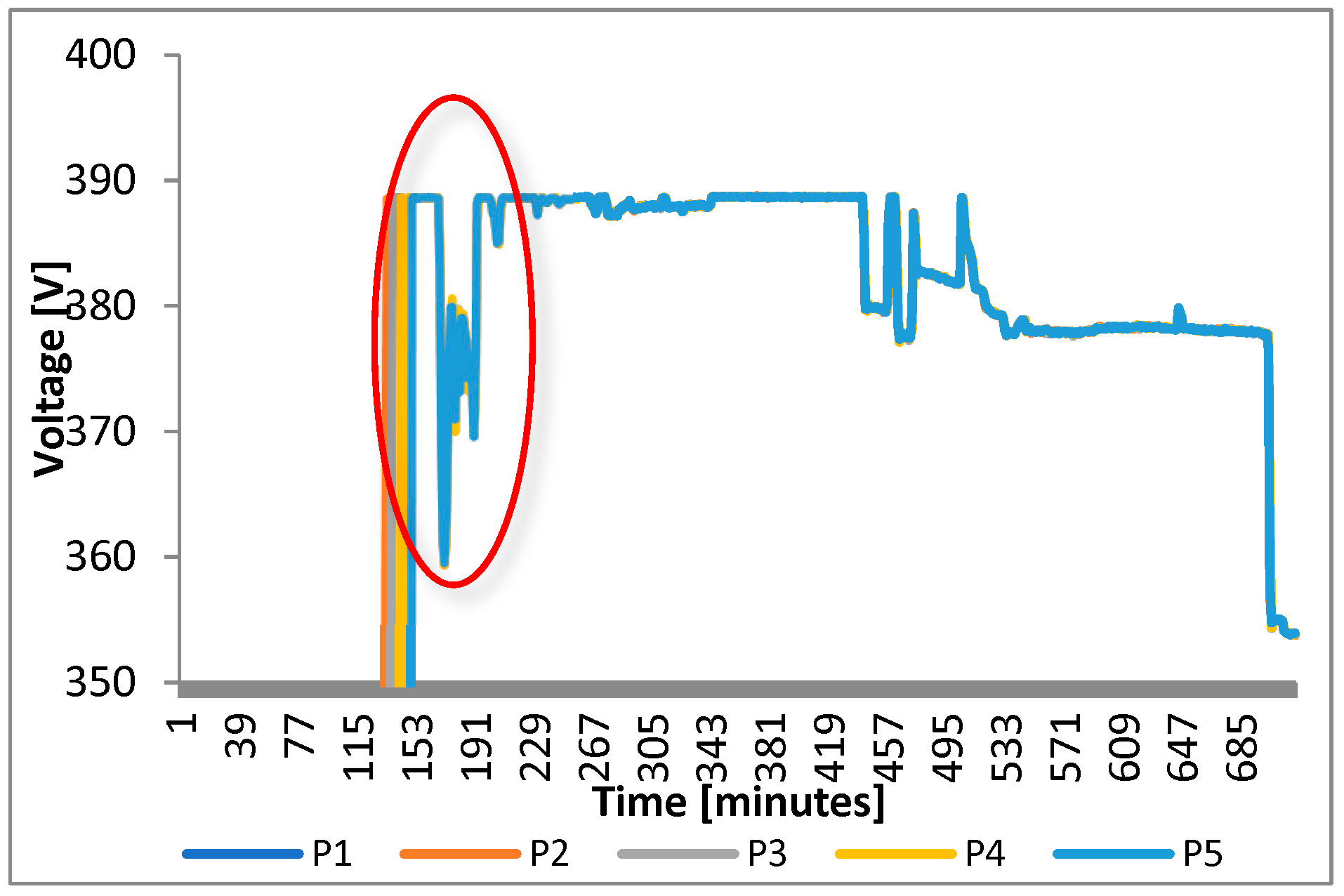

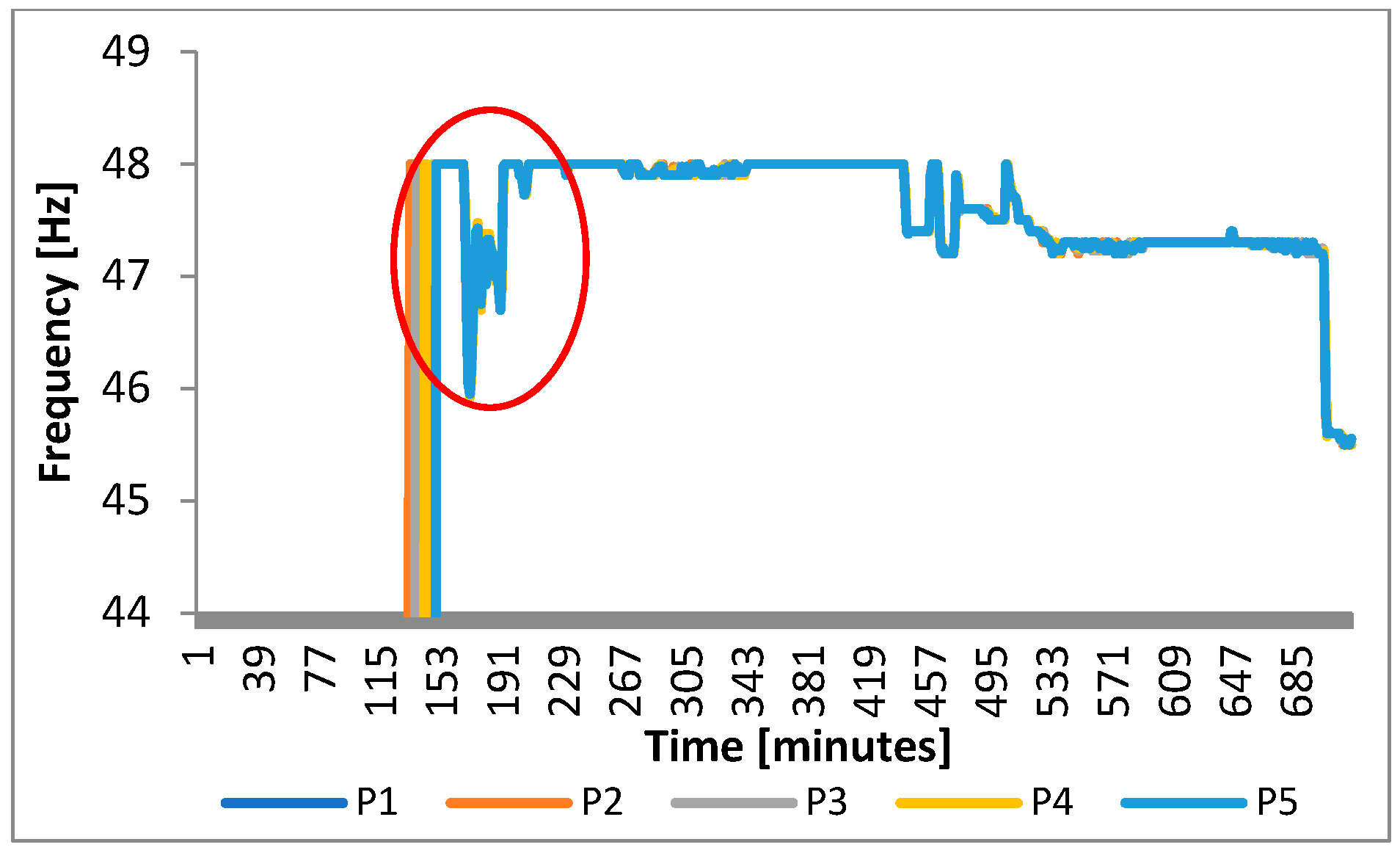
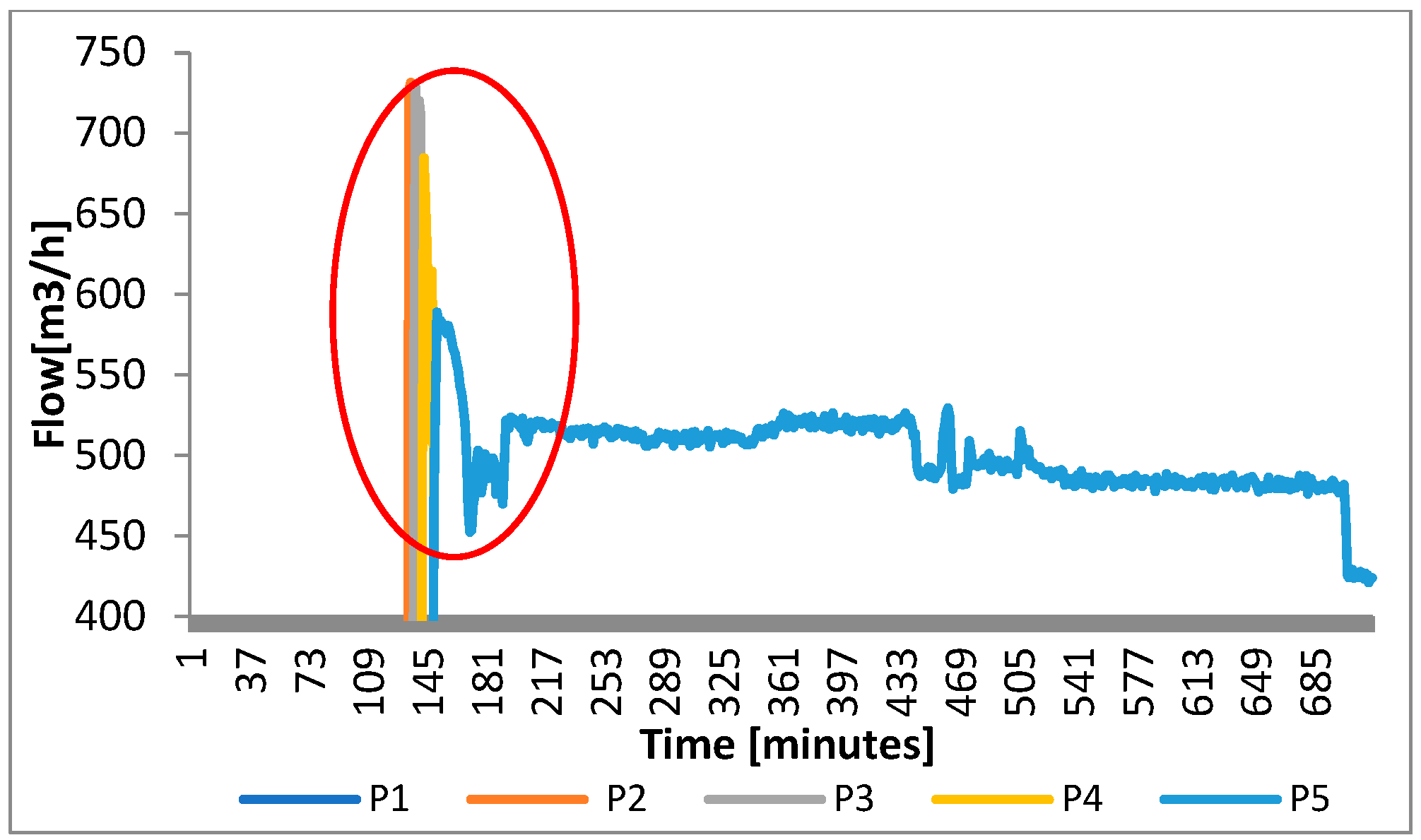
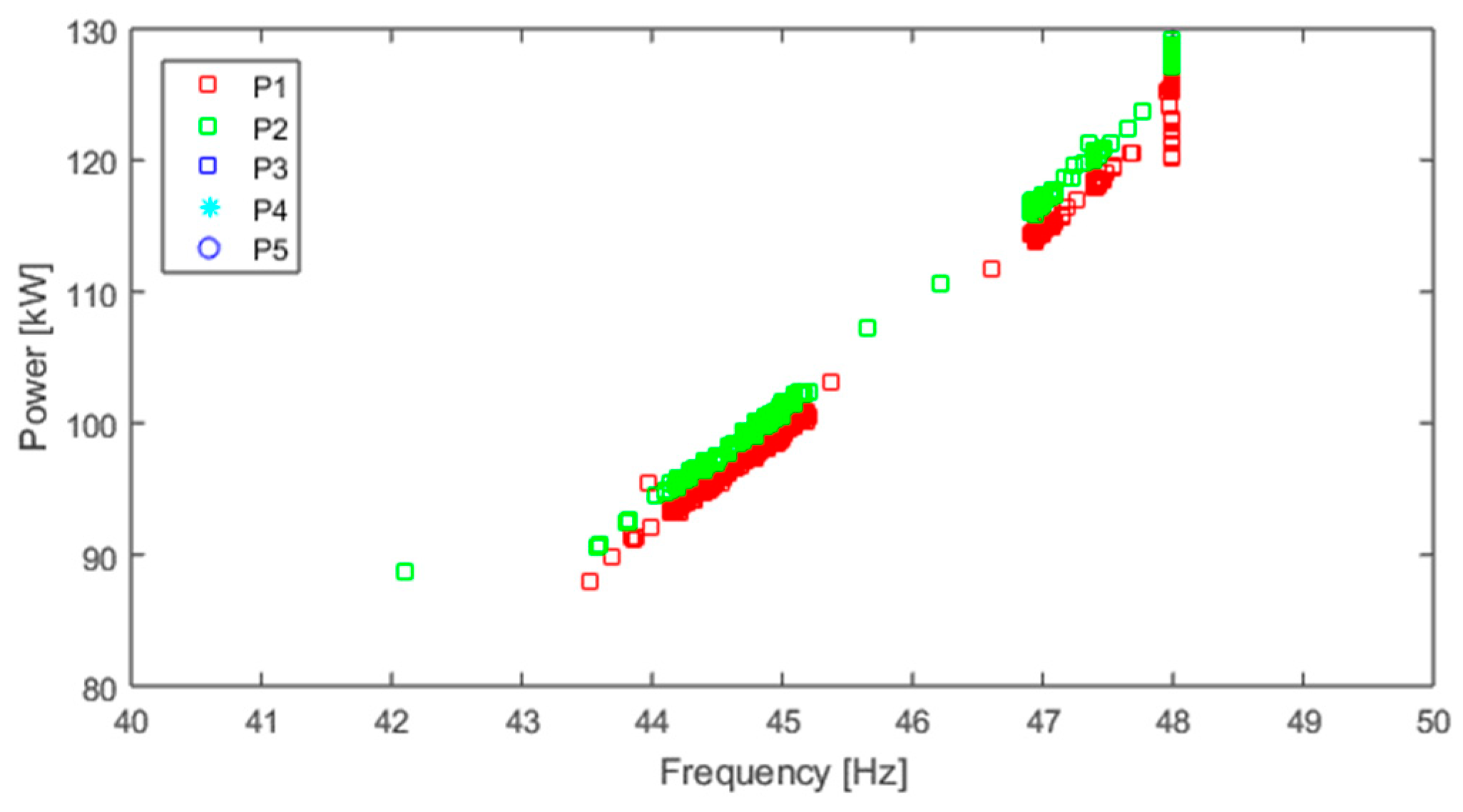
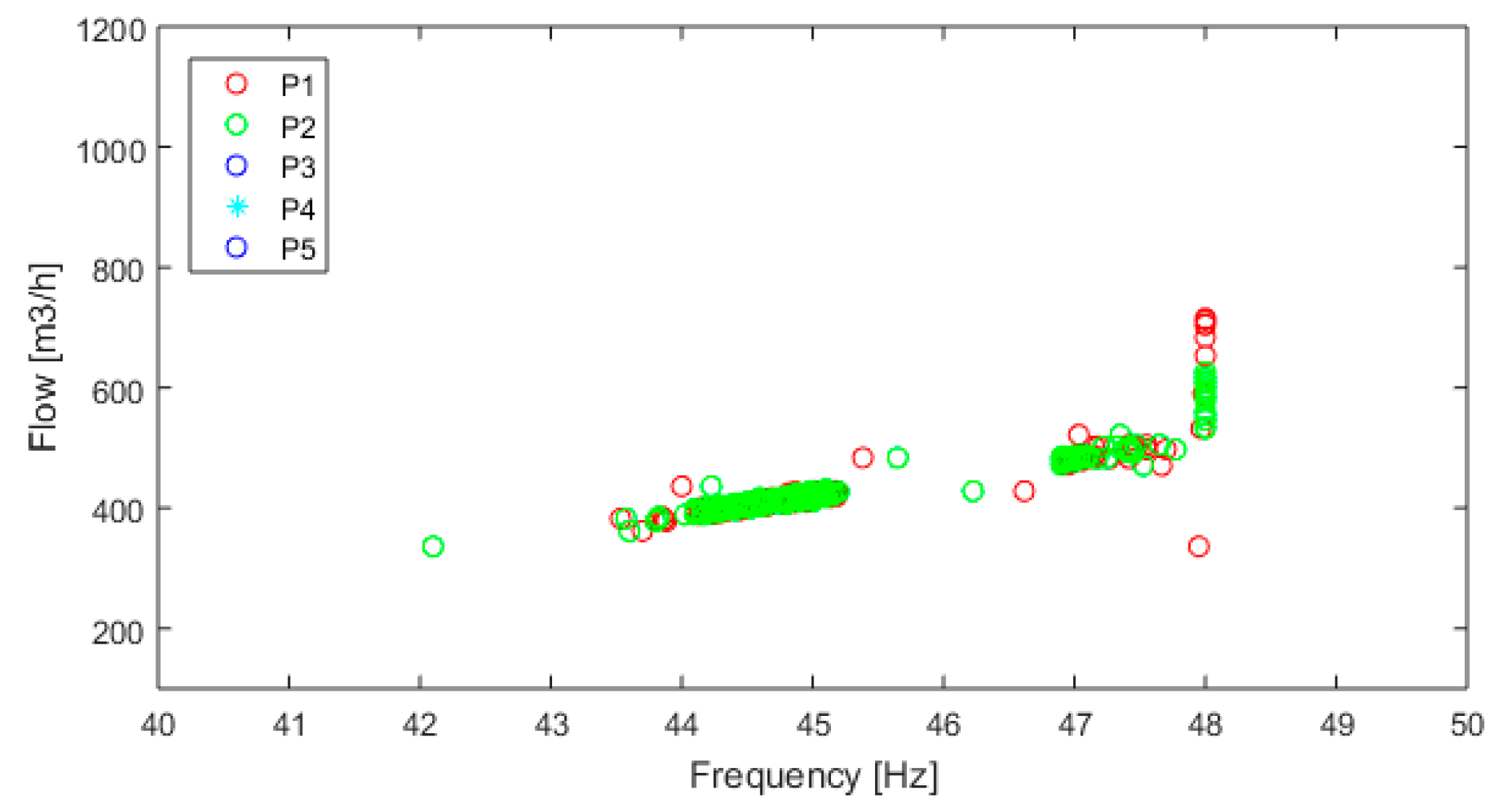

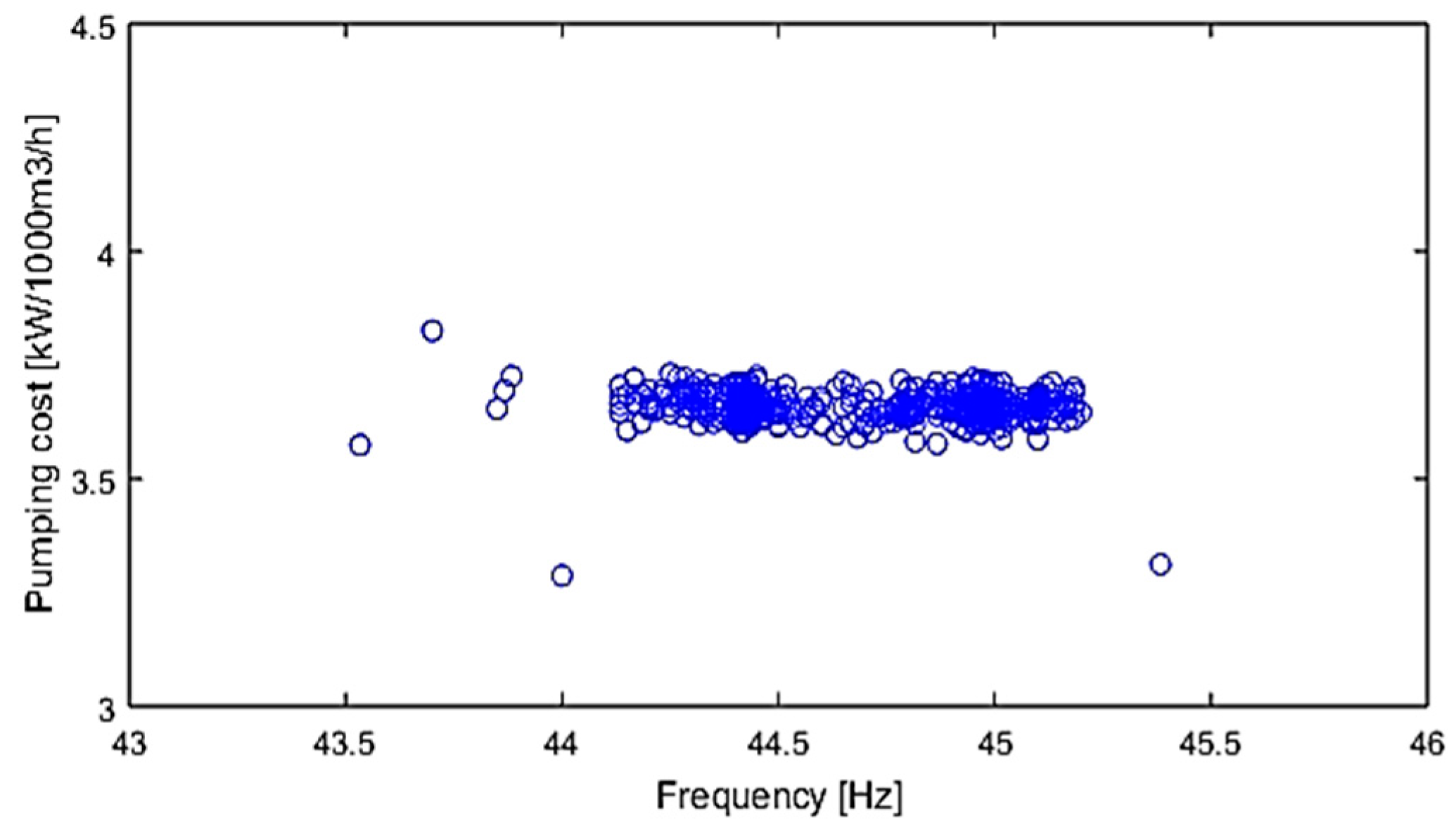
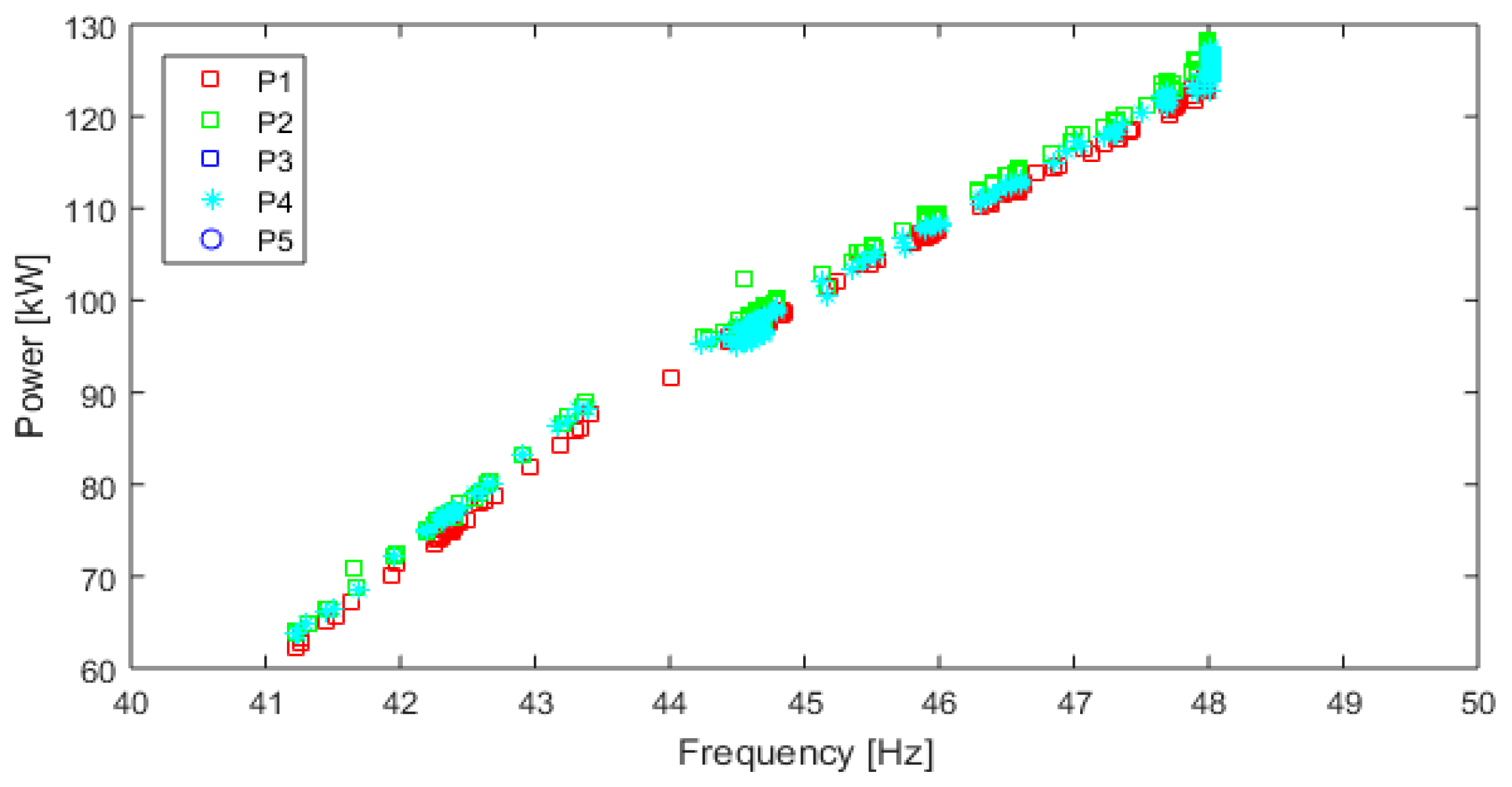

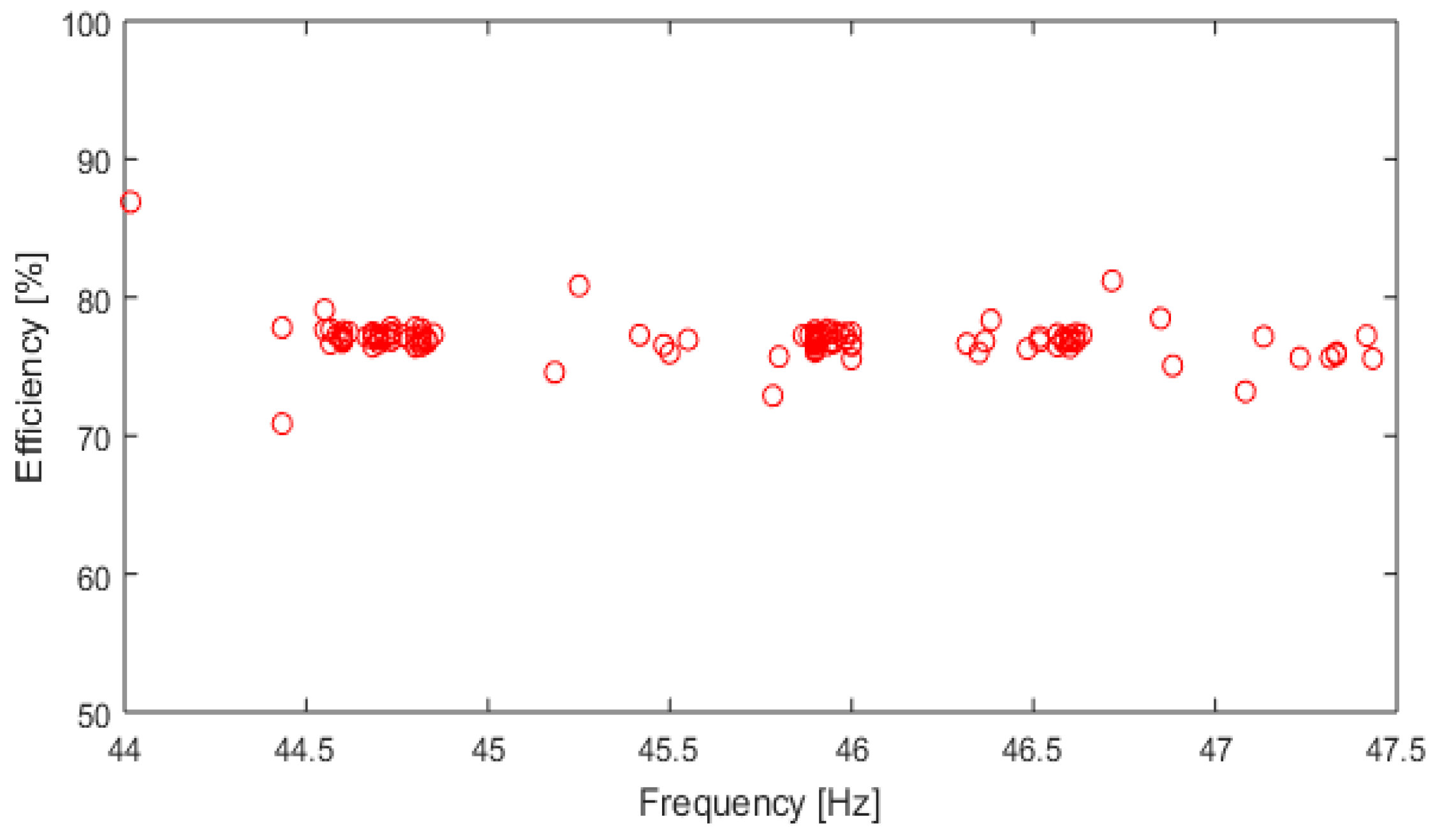
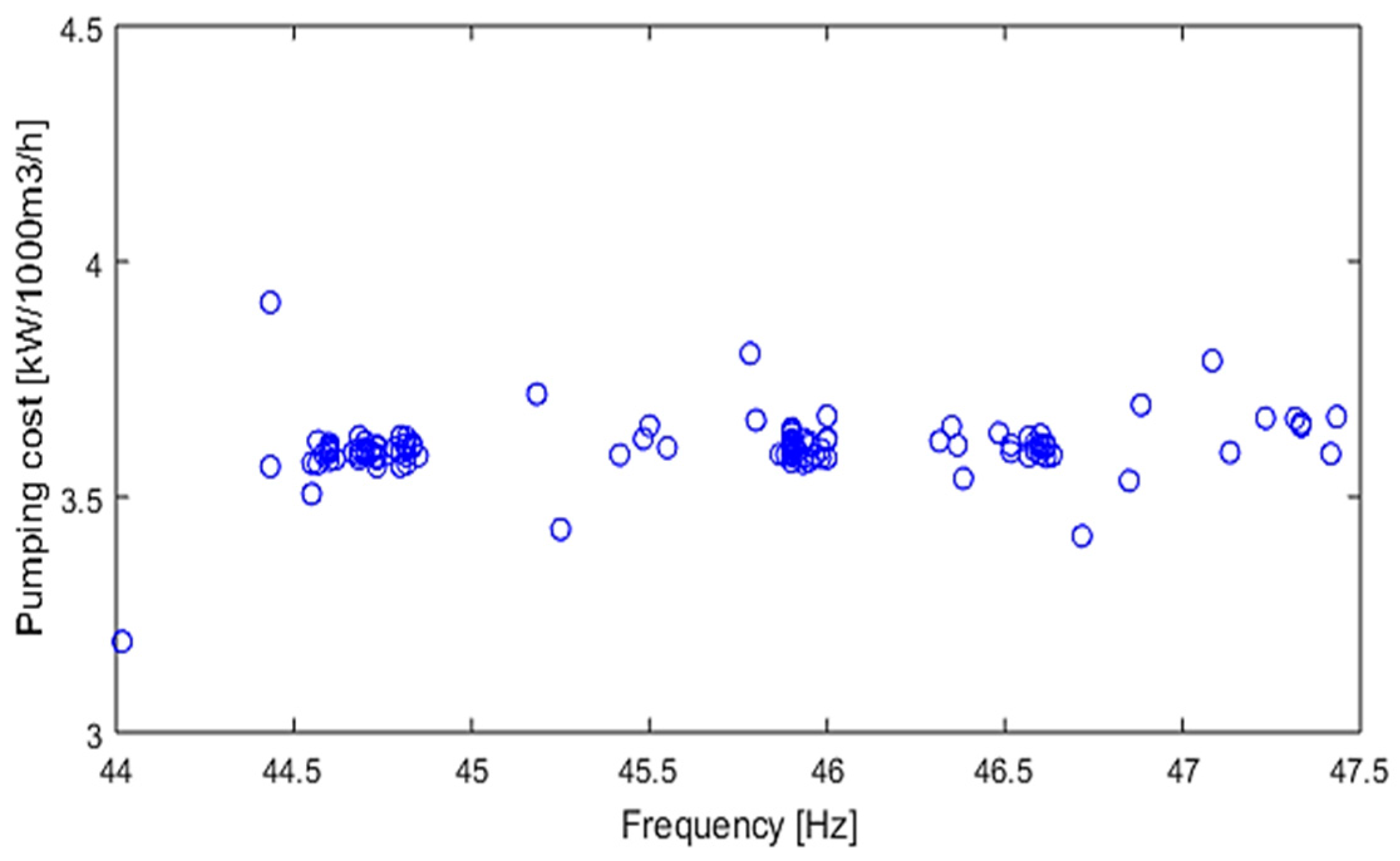


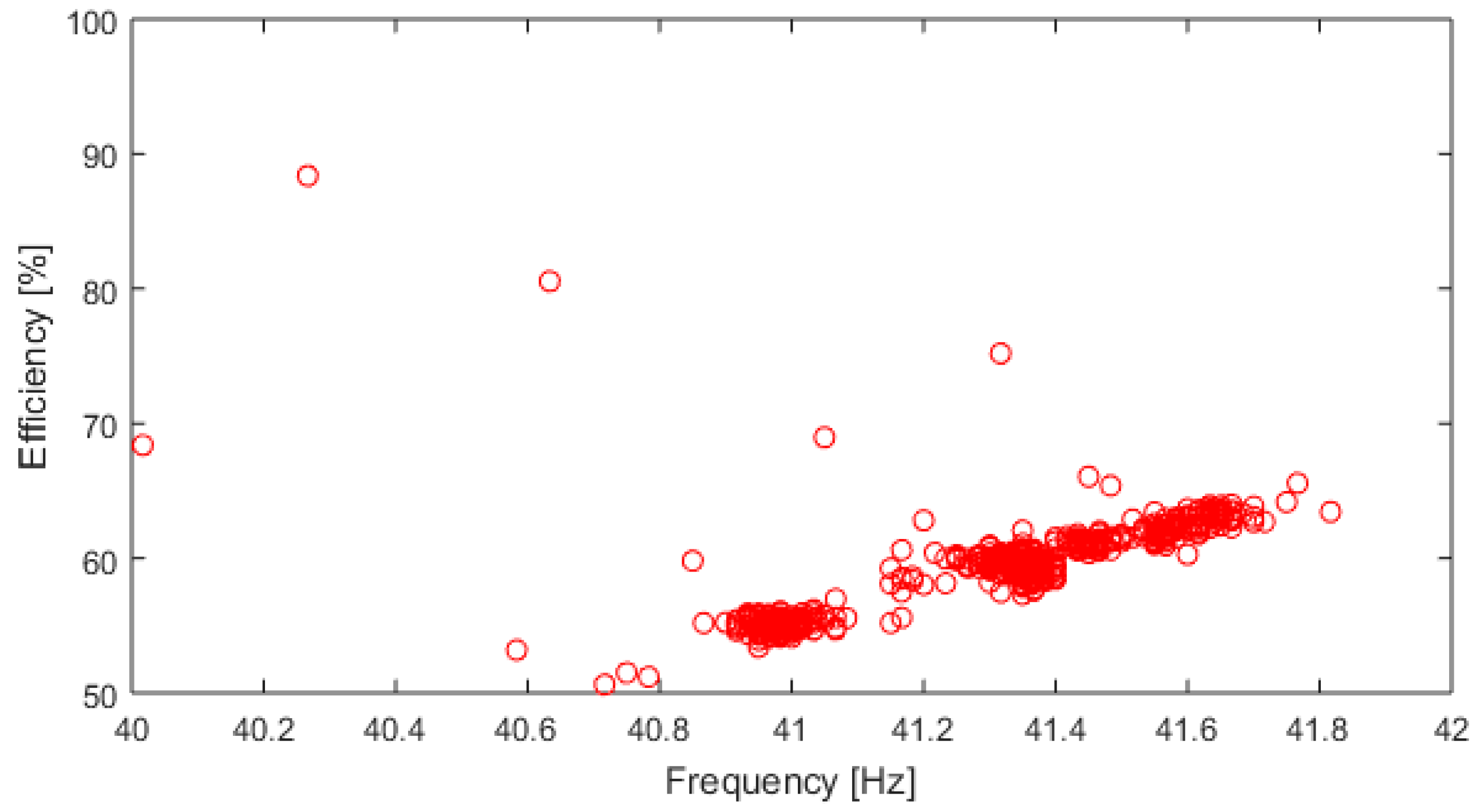
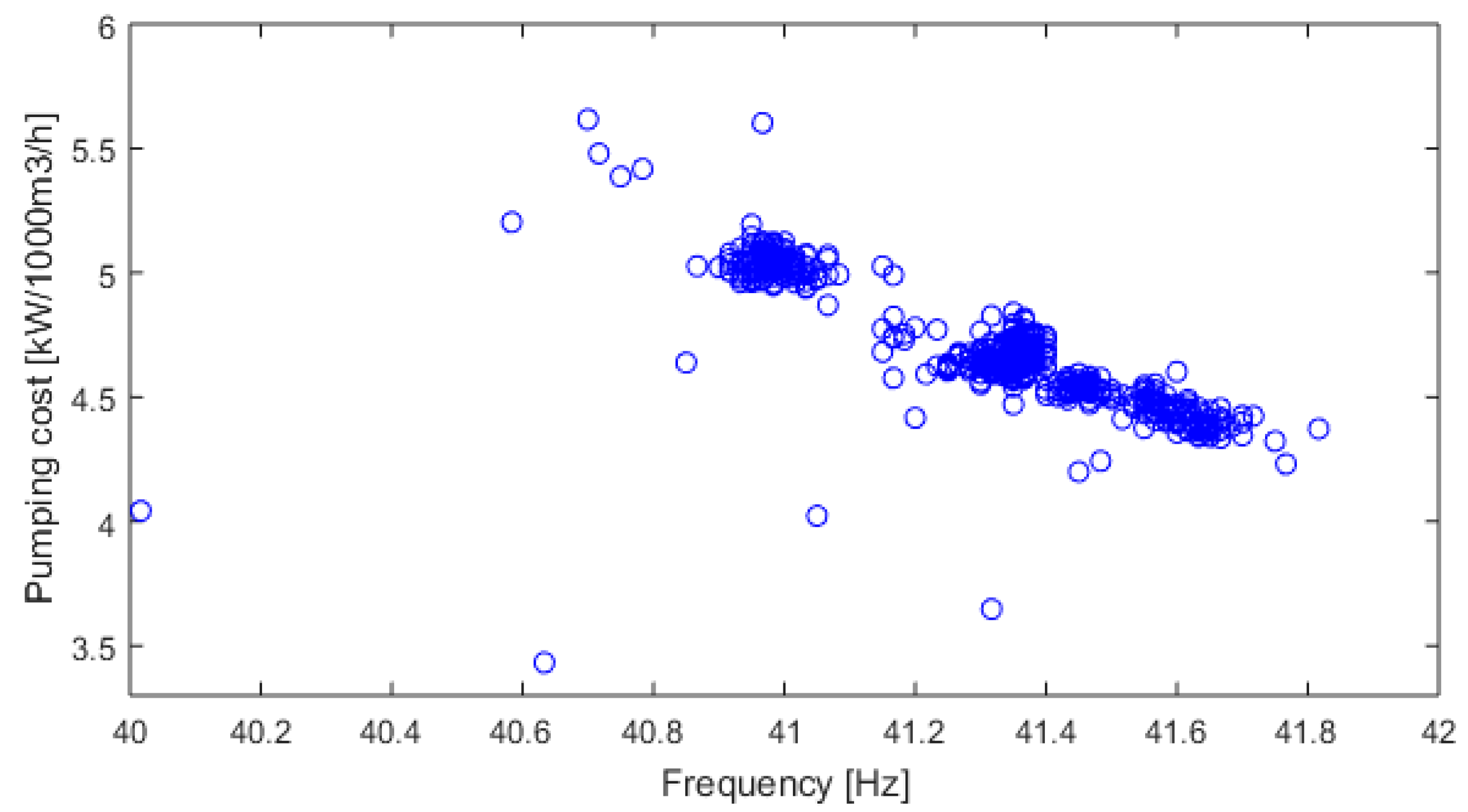
| Methods | |||
|---|---|---|---|
| Classical | Artificial Intelligence | ||
| Type of study | Water use | [13,14,15,17,19,20] | [21,24,25,27,28,29,30] |
| Energy consumption | [16,18] | [22,23,26] | |
| Operating Characteristics of the Vertical Pumps | |
|---|---|
| Service flow rate [m3/h] | 504 |
| Service head [m] | 84 |
| Qmin [m3/h] | 104.22 |
| Qmax [m3/h] | 800.07 |
| Hydraulic efficiency [%] | 82.6 |
| Electric Motor Characteristics | |||
|---|---|---|---|
| Nominal power [kW] | 160 | ||
| Rated frequency [Hz] | 50 | ||
| Rated current [A] | 277.1 | ||
| No. poles | Rotation speed [rotations/min] | 4 | 1485 |
| Power factor | 0.87 | ||
| Efficiency [%] | 96.2 | ||
| Hydraulic Regime | Flow [m3/h] | Pumping Cost [kW/1000 m3/mcH2O] | Efficiency [%] | Optimal Frequency Band [Hz] | |
|---|---|---|---|---|---|
| Case 1 | P1 | (810–850) | (3.64–3.7) | (75.3–76.4) | (44–45.5) |
| P2 | |||||
| Case 2 | P1 | (1230–1370) | (3.53–3.60) | (76.7–77.3) | (44.5–46.5) |
| P2 | |||||
| P4 | |||||
| Case 3 | P1 | (890–930) | (4.24–4.5) | (61.5–65.3) | (41.3–41.8) |
| P2 | |||||
| P3 | |||||
| P4 | |||||
Publisher’s Note: MDPI stays neutral with regard to jurisdictional claims in published maps and institutional affiliations. |
© 2021 by the authors. Licensee MDPI, Basel, Switzerland. This article is an open access article distributed under the terms and conditions of the Creative Commons Attribution (CC BY) license (https://creativecommons.org/licenses/by/4.0/).
Share and Cite
Scarlatache, F.; Grigoras, G.; Scarlatache, V.-A.; Neagu, B.-C.; Ivanov, O. A Hybrid Methodology Based on Smart Management Energy Consumption in Irrigation Systems. Electronics 2021, 10, 2864. https://doi.org/10.3390/electronics10222864
Scarlatache F, Grigoras G, Scarlatache V-A, Neagu B-C, Ivanov O. A Hybrid Methodology Based on Smart Management Energy Consumption in Irrigation Systems. Electronics. 2021; 10(22):2864. https://doi.org/10.3390/electronics10222864
Chicago/Turabian StyleScarlatache, Florina, Gheorghe Grigoras, Vlad-Andrei Scarlatache, Bogdan-Constantin Neagu, and Ovidiu Ivanov. 2021. "A Hybrid Methodology Based on Smart Management Energy Consumption in Irrigation Systems" Electronics 10, no. 22: 2864. https://doi.org/10.3390/electronics10222864
APA StyleScarlatache, F., Grigoras, G., Scarlatache, V.-A., Neagu, B.-C., & Ivanov, O. (2021). A Hybrid Methodology Based on Smart Management Energy Consumption in Irrigation Systems. Electronics, 10(22), 2864. https://doi.org/10.3390/electronics10222864










